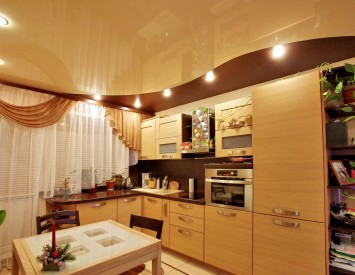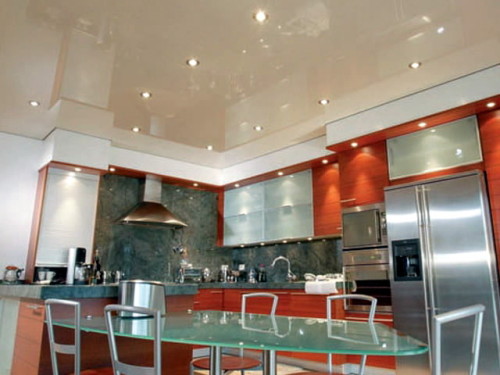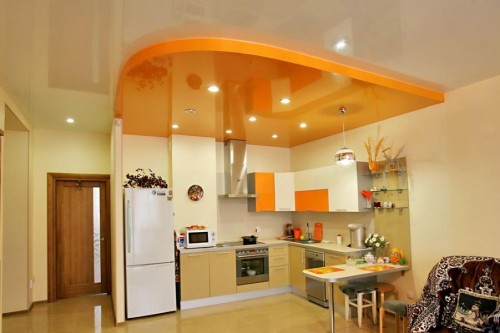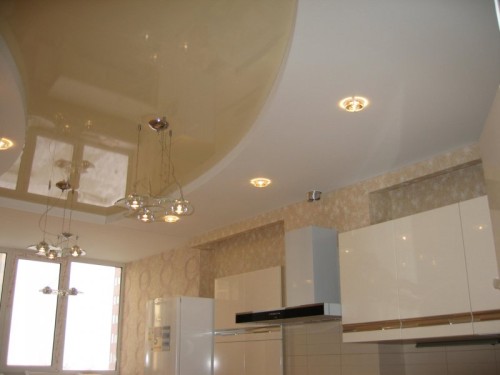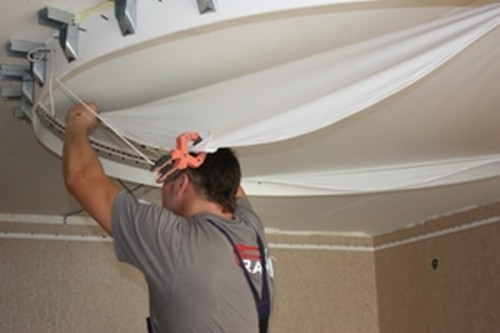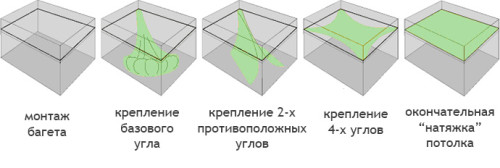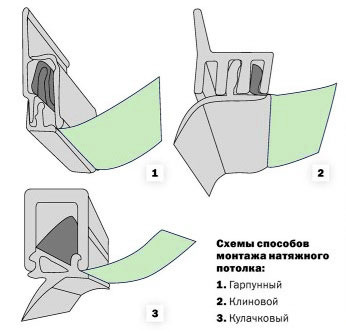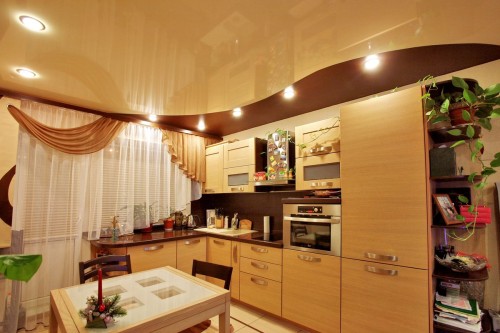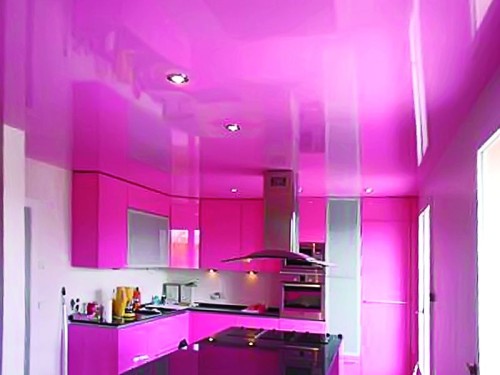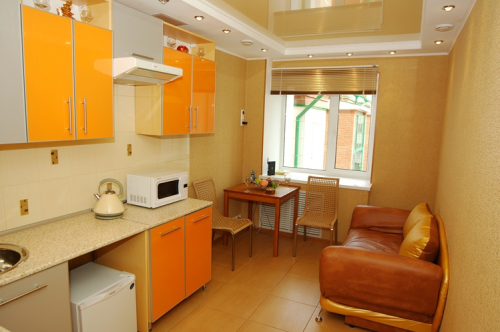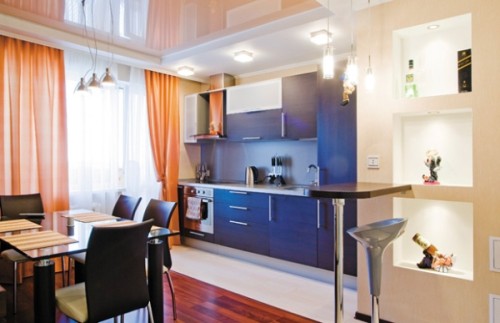Today, a stretch ceiling can be decorated in various ways. It gives sophistication to any room. The advantages of such a ceiling include its practicality and reliability. In addition, it is enough to rush to fungi and malicious microorganisms. For a long time, pollution does not settle for a long time and condensation does not appear. In addition, it is not subject to deformation when exposed to chemical components. The materials from which the stretch ceiling is made in the kitchen are not toxic and are not ignited. Slasps and cracks on it appear very rarely. In addition, stretch ceilings do not absorb smells. At the same time, they have good sound and thermal insulation. As for the warranty period for them, it is usually more than 12 years. Therefore, this is a very durable material.
Content
How to choose a stretch ceiling for the kitchen
When choosing a stretch coating, you should definitely take into account the style of the kitchen, interior features and the location of furniture. As a classic version, you can prefer a white glossy coating. This option is well suited for the kitchen decorated in the Art Nouveau or high-tech style. To visually increase the space of the room, you can use a special mirror film.
Today, there are so -called luminous stretch ceilings on sale, which, even without individual lighting devices, allow you to make the room lighter. Such muffled light gives the atmosphere of mystery. This ceiling consists of a light -permeable surface of the canvas and a lamp mounted on the base basis. If the lighting seems insufficient to you, then you can supplement it with built -in spotlights.
A good choice will be a combined ceiling, which combines a suspended and stretch coating. As for the cost of multi -level ceilings, it is almost the same as the price of coatings from other materials. In addition, they do not need a lot of time to install them, as it seems at first glance. To do this, it is enough to make holes and install the fastener profile. It is also worth noting that the film of suspended ceilings is environmentally friendly, which is confirmed by the corresponding quality certificates.
Types of suspended ceilings
Before we consider how stretch ceilings are pulled, we will get acquainted with their species. As a material for this design, glossy, satin, textured and matte films are used.
Using a glossy film, the ceiling can be given the effect of reflection, which visually increases the space of the room. Thanks to satin material, you can get a beautiful and bright surface painted in any color. With a matte film, the ceiling seems perfectly even. It is worth saying that any of the above materials is quite moisture resistant and is not subject to corrosion processes. It is quite easy to care for such ceilings. So, in order to remove dust and dirt, you can use any detergent. The main thing is that its composition does not have alcohol and abrasive elements.
Existing suspended ceilings today according to the materials used are divided into:
- textile,
- polyvinyl chloride.
The latter option is a design of vinyl paintings, which are fixed using a profile of plastic or aluminum. The width of the finished film rolls can reach 4.5-6 m. Usually, the surface is measured first, and then according to the data obtained, the manufacture of a certain amount of material is ordered.
Let us consider in more detail the characteristics of each type of material for a stretch ceiling:
- For almost any style of the interior of the kitchen, whether it is a modern or an empire, a glossy stretch ceiling in the kitchen is suitable. Today there is a large range of material differing in color and texture.
- For small kitchen rooms, ceilings with a mirror surface will be an excellent option. They can visually expand the area. The disadvantage of such paintings is a noticeable seam.
- Satin stretch ceilings have similar properties of both matte and glossy canvases. Thus, they also visually make the room wider. But they reflect much less details than glossy.
- If you make a white matte stretch ceiling in the kitchen, then the surface will look like perfectly plastered. Although, there are other shades of such canvases. In any case, glare will not be present on the matte canvas and, therefore, the surface color will not be distorted. In addition, such a ceiling is good because the seam is almost not visible on it.
- If you want something original, then you can make a ceiling in the form of a starry sky. The stars on it will flicker at the expense of the projector and fiber fiber threads brought to one of the sides of the canvas. The color of the stretch ceiling in the kitchen in this case should correspond to the shade of the starry sky, i.e. It will be black or dark blue.
- Textile suspended ceilings usually look very good in the kitchen decorated in country style. Such products are whole and seamless fabric canvases. They are made of polyester threads that are saturated with polyurethane. At the same time, the width of this material is usually about 6 m. For the construction of the ceiling, it is enough to simply cut off a piece of the required size from the roll.
- PVC film ceilings restrain moisture well. Such a surface will not lose its appearance, even if the neighbors suddenly flood your apartment on top. The canvas under the weight of water, of course, will sag, but the furniture and other decoration existing here will remain untouched. Then the water will need to be carefully drained from the surface. To avoid damage to the canvas for this work, you can invite specialists. After draining the accumulated water, the ceiling usually takes on its former appearance.
In any case, you yourself decide what material to install the ceiling in your kitchen. Each of them has both advantages and disadvantages.
Installation of a stretch ceiling: Technology
If you plan to install a two -level structure for the ceiling, then the construction of a special frame will be required.
The procedure for conducting installation work will be as follows:
- Initially, you should take measurements and determine the lower point on the ceiling. From it, the level of crate for drywall is noted. At the same time, keep in mind that the ceiling itself will be located below the erected frame. Therefore, you need to retreat from the upper point of the ceiling by about 50-60 mm.
- The height of the stretch ceiling can be adjusted depending on the size of your kitchen room. Using a simple building level, a mark is made in each corner of the room. Between all marks, you should repel the line with a molar cord, on which you will be guided by the installation of the frame. In this case, the UD profile is screwed around the perimeter.
- The next step must be clearly indicated in advance what form should eventually take a stretch ceiling. This is best done by drawing on the main ceiling of the corresponding figure. Next, you need to indicate the number of profiles and fasteners that will be required to build the structure.
- After you calculated the stretch ceiling and the number of required installation materials, we proceed to the construction of the frame. According to the marked sketch on the P-shaped suspensions, a gypsum-plane UD- or UV profile is mounted.
- Then the side planes of the installed profile will need to be cut every 50 mm. As a result, the material will become much more flexible.
- In order for the frame to acquire the necessary stiffness, a jumper of CDs is installed between the internal and parietal profile.
- In any room, including in the kitchen, there should be sufficient lighting. Therefore, it is necessary to provide a place where it will be possible to make wiring. It is usually located at the same level with drywall.
- If it is planned to install lamps on the ceiling itself, then it will be necessary to make a removal of wires to the corresponding places.
- The wiring, which will be hidden under the plane of the laid ceiling, should be packaged in a corrugated sleeve and fixed with something to the main frame. There should be no joints and wire connections in the deaf zone. Such a place, for example, is the space between the main and suspended ceiling. Due to twisting, a spark may occur, and with any malfunction you will have to disassemble the entire ceiling.
- Before hanging a stretch ceiling, you need to sheathe the frame with a drywall and put the surface. The material sheet is screwed so that the mounted ceiling can be installed on the base. Gypsum cardboard is usually fixed with screws with a length of 27 mm. Moreover, there should be a distance of at least 310 mm between them.
- The existing excesses on the figure are later simply cut with a hacksaw. It is important that the vertical strip is cut in accordance with the size, after which a paper layer is cut every 50 mm on it. This is necessary so that the material can bend. During the twisting of screws into the sheets of drywall, their heads can break through the paper. To avoid this, there is a special nozzle. It can be used for installation.
- Before you start installing a stretch ceiling, it is advisable to thoroughly subsided and fumbled with a plasterboard structure. Then, after installation, everything will be ready without any improvements. In addition, you can mount point sources of light on sheets of drywall in advance.
To install polyvinyl chloride film, a profile of plastic or metal is first attached to each wall of the room. Then the air temperature is increased to 45 degrees. The film heats up with a heat loss to about 55 degrees. Then the canvas is refueled in the baguette. Due to the increase in temperature, the material is stretched until it takes the necessary dimensions, and when it cools down, it will squeeze and “fall into place”. Thus, it turns out a beautiful and perfectly flat surface.
Installation of lamps
If you wondered how to make a stretch ceiling, then, first of all, think about lighting. Most often, point lamps are placed on such structures, but no one forbids the use of any lighting at will. Consider the placement of lighting devices in advance. The wires for installing lighting must be diluted even before the canvas tension. The wiring is necessarily packaged in a special corrugated sleeve (corrugation), after which it is attached to the main ceiling.
Stretch ceiling in the kitchen: photo
